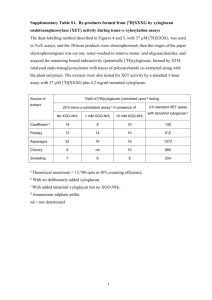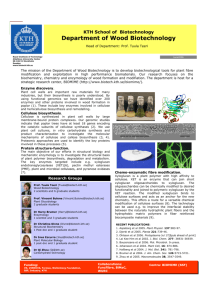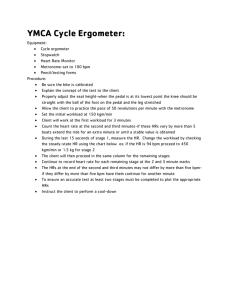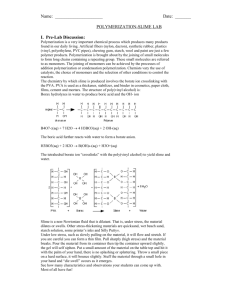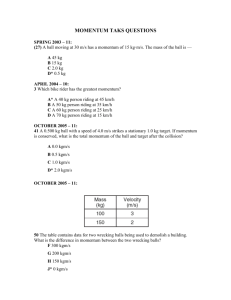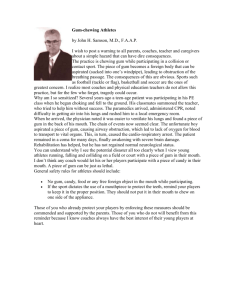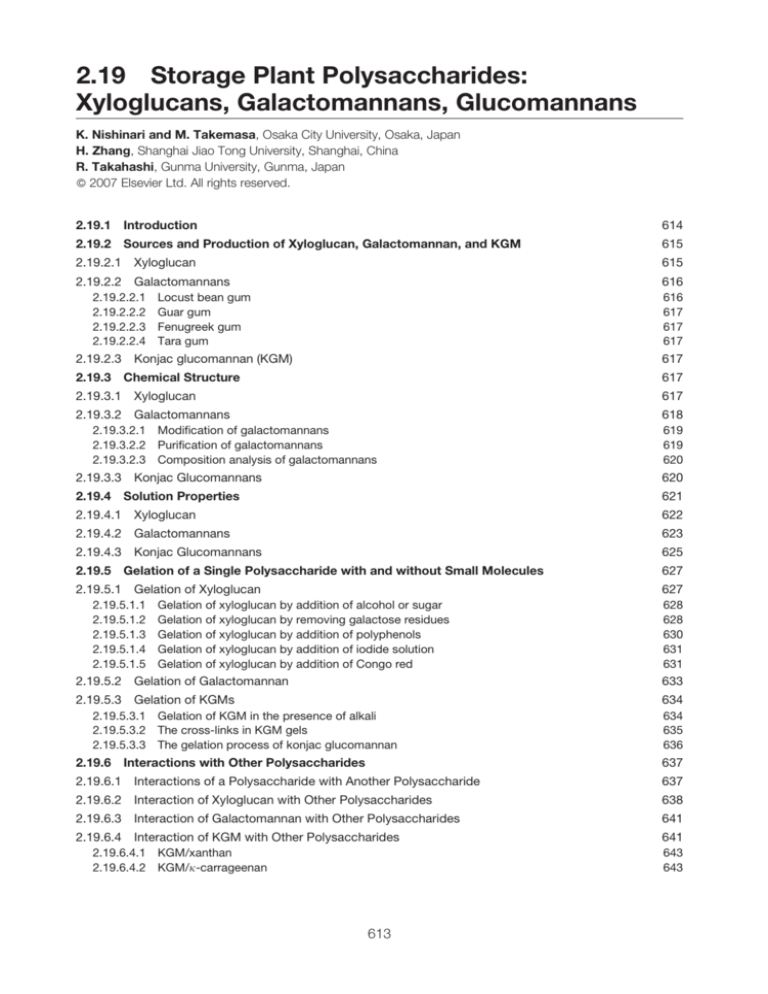
2.19 Storage Plant Polysaccharides:
Xyloglucans, Galactomannans, Glucomannans
K. Nishinari and M. Takemasa, Osaka City University, Osaka, Japan
H. Zhang, Shanghai Jiao Tong University, Shanghai, China
R. Takahashi, Gunma University, Gunma, Japan
ß 2007 Elsevier Ltd. All rights reserved.
2.19.1 Introduction
614
2.19.2 Sources and Production of Xyloglucan, Galactomannan, and KGM
615
2.19.2.1
Xyloglucan
615
2.19.2.2
Galactomannans
616
2.19.2.2.1
2.19.2.2.2
2.19.2.2.3
2.19.2.2.4
2.19.2.3
Locust bean gum
Guar gum
Fenugreek gum
Tara gum
616
617
617
617
Konjac glucomannan (KGM)
617
2.19.3 Chemical Structure
617
2.19.3.1
Xyloglucan
617
2.19.3.2
Galactomannans
618
2.19.3.2.1
2.19.3.2.2
2.19.3.2.3
2.19.3.3
Modification of galactomannans
Purification of galactomannans
Composition analysis of galactomannans
Konjac Glucomannans
619
619
620
620
2.19.4 Solution Properties
621
2.19.4.1
Xyloglucan
622
2.19.4.2
Galactomannans
623
2.19.4.3
Konjac Glucomannans
625
2.19.5 Gelation of a Single Polysaccharide with and without Small Molecules
627
2.19.5.1
627
Gelation of Xyloglucan
2.19.5.1.1
2.19.5.1.2
2.19.5.1.3
2.19.5.1.4
2.19.5.1.5
Gelation of xyloglucan by addition of alcohol or sugar
Gelation of xyloglucan by removing galactose residues
Gelation of xyloglucan by addition of polyphenols
Gelation of xyloglucan by addition of iodide solution
Gelation of xyloglucan by addition of Congo red
628
628
630
631
631
2.19.5.2
Gelation of Galactomannan
633
2.19.5.3
Gelation of KGMs
634
2.19.5.3.1
2.19.5.3.2
2.19.5.3.3
Gelation of KGM in the presence of alkali
The cross-links in KGM gels
The gelation process of konjac glucomannan
634
635
636
2.19.6 Interactions with Other Polysaccharides
637
2.19.6.1
Interactions of a Polysaccharide with Another Polysaccharide
637
2.19.6.2
Interaction of Xyloglucan with Other Polysaccharides
638
2.19.6.3
Interaction of Galactomannan with Other Polysaccharides
641
2.19.6.4
Interaction of KGM with Other Polysaccharides
641
2.19.6.4.1
2.19.6.4.2
KGM/xanthan
KGM/k-carrageenan
643
643
613
614
Storage Plant Polysaccharides: Xyloglucans, Galactomannans, Glucomannans
2.19.7
Applications
645
2.19.7.1
Galactomannans
645
2.19.7.2
Konjac Glucomannans
646
2.19.1 Introduction
The production, structure, properties, functions, and applications of three polysaccharides (galactomannans, konjac
glucomannans (KGMs), and xyloglucans) are reviewed in this chapter.
Xyloglucans are linear plant polysaccharides with side chains and are present as a storage polysaccharide in the cell
walls of higher plants. The backbone structure is (b1!4)-linked D-glucan. A part of glucose unit is substituted with
a-D-xylose at the O6 position. This structure is common for all the xyloglucans, but additional residues are attached
depending on the source, and the physicochemical properties and functionality are governed by the number and
position of these residues. Most widely studied xyloglucan is tamarind seed xyloglucan (TSX), because only TSX
existing in the seed of tamarind tree (Tamarindus indica) as a storage polysaccharide has been commercially available.
Hence, TSX is most extensively studied, and the study of TSX especially on the rheological behavior is mainly
introduced here. TSX has four types of repeating units that differ in the number and the position of galactose
substituting the xylose. TSX is widely used in food industries, for instance, as thickener, stabilizer, and/or gelling
agent. Aqueous solutions of TSX usually show almost a Newtonian behavior although this depends on the concentration and the molar mass. By adding sugar or alcohol, the viscosity of TSX solution is significantly affected, and in the
presence of a large amount of these substances TSX can form a gel. Although aqueous solutions of native TSX alone
cannot form a gel, synergistic gel can be formed by mixing with other polysaccharides, or with a dye such as Congo red,
or polyphenol, such as epigallocatechin gallate (EGCG).
Galactomannans are widely distributed in nature and have attracted considerable academic attention as well as
industrial interest due to their thickening and gelling properties in aqueous media. They are generally heterogeneous,
linearly branched polysaccharides based on a backbone of (b1!4)-linked D-mannopyranose (Man) residues to which
are attached (1!6)-linked D-galactopyranose (Gal) residues. The rheological properties of dispersions of galactomannans depend on the molar mass and the degree of substitution: locust bean gum, Gal/Man ¼ 1/4; in taragum, Gal/
Man ¼ 1/3; in guar gum, Gal/Man ¼ 1/2; and in fenugreek gum, Gal/Man ¼ 1/1. Mixtures of galactomannans with
xanthan and carrageenan have been studied extensively. Recent advances in the understanding of conformation,
rheological behavior of dispersions of galactomannans, and gelation of galactomannans with other polysaccharides and
with borax are described.
KGM is derived from the tuber of Amorphophallus konjac C. Koch, and its gels have been important food materials in
Asia especially in Japan and China. The glucomannan backbone possesses 5–10% acetyl-substituted residues, and it is
widely accepted that the presence of substituted group confers solubility to the glucomannan in aqueous solution. If
the molecules of KGM lose their acetyl groups with the aid of alkalis, the aqueous solution of KGM is transformed into
a thermally stable gel. This gelation process is promoted by heating. The addition of alkali to KGM dispersion not only
enhances their solubilization but also facilitates the deacetylation of the chain. The physicochemical properties,
however, have not been fully elucidated mainly because of the difficulty in obtaining easily soluble and wellfractionated KGM samples. Recent studies on the effect of molar mass and the acetyl group content in KGM molecule
on the gelation mechanism of KGM dispersions are described.
As is always the case with natural polysaccharides, the structure of these storage polysaccharides is complicated in
the sense that the arrangement and distribution of repeating units is not homogeneous and the chemical formula of
repeating unit shown in papers and textbooks is only an idealized or averaged one and does not represent a specific
structure of the experimental sample described there. Ratio of sugar units constituting each polysaccharide is reported
as glucose:xylose:galactose ¼ 0.46:0.36:0.17 in TSX; locust bean gum (Gal/Man ¼ 1/4), tara gum (Gal/Man ¼ 1/3), guar
gum (Gal/Man ¼ 1/2), fenugreek gum (Gal/Man ¼ 1/1) in galactomannans; and Man/Glc ¼ 3/2 in KGM. Not only the
ratio of these sugar units but also the arrangement and the distribution of these sugar units are not so well established
and depend on the origin of these polysaccharides: the distribution of side groups is not homogeneous; galactose
residues on the mannose main chain is not evenly distributed in galactomannans; some regions are sparsely substituted
while the others are densely substituted.
615
Storage Plant Polysaccharides: Xyloglucans, Galactomannans, Glucomannans
2.19.2 Sources and Production of Xyloglucan, Galactomannan, and KGM
2.19.2.1 Xyloglucan
Xyloglucan is a generic name of linear polysaccharides consisting of (b1!4)-linked D-glucan substituted with xylose,
and generally can be found in plant cell walls. The primary cell wall consists of cellulose microfibrills embedded in a
matrix which is made from pectins and hemicelluloses. Xyloglucan is the most abundant hemicellulosic polysaccharide in the primary cell wall of most vascular plants. The network structure made of cellulose and xyloglucan network
is believed to be the major load-bearing structure in the primary cell wall.21 It is proposed that the xyloglucan
transglucosylhydrolases cut the backbone of xyloglucan, and this induces the reformation of the network structure,
and thus expansion and growth keeping the mechanical strength.
In some seeds of trees (such as Tamarindus, Impatiens, Annona, Tropaeolum, Hymenaea, and Detarium), xyloglucan
polymer also exists as a storage polysaccharide.1,13
The backbone of xyloglucan is (b1!4)-linked D-glucan, which is the same as cellulose, and three out of four glucose
residues are substituted with a-D-xylose at the O6 position. This is the common structure for all the xyloglucans, but
additional residues are attached to xylose, depending on the source of xyloglucan. This variation of the structure
dominates the detail of the functionality and physicochemical properties. For instance, the galactose substituted to the
xylose dominates the water solubility in the case of xyloglucan extracted from tamarind seed.
It is known that there are different sources of xyloglucan used as food additives, such as detarium xyloglucan from
Detarium senegalense J. Gmelin, Afzelia africana, and Jatoba. As far as we know, for the solution and rheological
properties of xyloglucan polymer, the most widely studied xyloglucan is TSX, because only TSX is commercially
available at present.22,23 The difference in the degree of galactose substitution largely affects the solubility in water
and the degree of association between xyloglucan molecules, so the effect of the galactose substitution ratio and
the composition of the repeating units is important when considering the properties of the aqueous solutions of
xyloglucan.
The effect of the type of xyloglucan on the physicochemical properties has also been reported. Some xyloglucans
have an additional residue, fucose or arabinose, attached to the galactose residues at the end of side chain, but the
above-mentioned storage xyloglucans do not, probably suggesting that the chemical structure is optimized for the
raison d’être.
York et al. performed an exhaustive study of the branching pattern of xyloglucan in relation to the plant species.
They found that a branching pattern strongly depends on species.21 For example, the repeating unit of Lactuca sativa,
Tanacetum ptarmiciflorum, and Daucus carota is XXXG-type (see Figure 1 for the abbreviation such as X and G)
branching pattern, which is a typical xyloglucan repeating unit, but these contain a-D-Xylp, b-D-Galp-(1!2)-a-D-Xylp,
and a-L-Fucp-(1!2)-b-D-Galp-(1!2)-a-D-Xylp side chains. However, there are atypical species, such as Capsicum
annuum (pepper) and Lycopersicon esculentum (tomato), which preclude atypical branching patterns. These have
a-D-Xylp
a-D-Xylp
a -D-Xylp
1
1
1
↓
↓
↓
6
6
6
→4)-b -D-Glcp -(1→4)-b-D-Glcp-(1→4)-b-D-Glcp-(1→4)-b-D-Glcp-(1→
X
X
X
G
b-D-Galp
1
↓
2
a -D-Xylp
a -D-Xylp
a -D-Xylp
1
1
1
↓
↓
↓
6
6
6
→4)-b-D-Glcp -(1→4)-b -D-Glcp-(1→4)-b-D-Glcp-(1→4)-b-D-Glcp-(1→
X
L
X
b-D-Galp
b-D-Galp
1
1
↓
↓
2
2
a -D-Xylp
a -D-Xylp
a -D-Xylp
1
1
1
↓
↓
↓
6
6
6
→4)-b -D-Glcp -(1→4)-b -D-Glcp -(1→4)-b -D-Glcp -(1→4)-b -D-Glcp -(1→
X
L
L
G
b -D-Galp
1
↓
2
a -D-Xylp
a -D-Xylp
a -D-Xylp
1
1
1
↓
↓
↓
6
6
6
→4)-b -D-Glcp -(1→4)-b -D-Glcp -(1→4)-b -D-Glcp -(1→4)-b -D-Glcp -(1→
G
Figure 1 The chemical structure of the repeating unit of xyloglucan.
X
X
L
G
616
Storage Plant Polysaccharides: Xyloglucans, Galactomannans, Glucomannans
XXGG-type, less-branched type, repeating unit. On the other hand, species such as Ipomoea purpurea (morning glory,
order Solanales), Ocimum basilicum (basil, order Lamiales), and Plantago major (plantain, order Lamiales) have an
unusual XXGGG-type branching pattern. They have five glucoses in the backbone, although the number of glucose
in backbone of the repeating unit is four for most xyloglucans. According to their study, the appearance of this
intermediate xyloglucan structure in oleander has implications regarding the evolutionary development of xyloglucan
structure and its role in primary plant cell walls.
In the case of xyloglucan as the storage polysaccharide, xyloglucan exists as a polymer in the seeds. The reported
molar mass of TSX is 650 000 (gel permeation chromatography; GPC)22 or 880 000 g/mol (light scattering).12 TSXs are
used as food additives as a thickener, a gelling agent in the presence of other additives, a starch modifier, an emulsion
stabilizer, an ice-crystal stabilizer, etc. exploiting the characteristics, such as Newtonian flow behavior in the wide
range of shear rate, water-holding ability, and their resistance against heat, salt, and pH regimes used in the processing
of foods.
2.19.2.2 Galactomannans
Seed galactomannans are mostly obtained from the endosperms of the seeds of leguminous plants.24–26 Some seed
galactomannans from nonleguminous sources are found in Cocos nucifera, Coffea arabica, Elaies guineensis, Phoenix
dactylifera, Phytelephas macrocarpa, etc. In a few exceptional cases, for example, in Glycine max, Gymnocladus dioica, or
Mucuna, galactomannans occur in the hull, the inner side of the seed coat, and kernel, respectively (Table 1).
The genes encoding the enzymes that add sugar residues to the polymannose backbones in galactomannan have
been isolated by enzyme purification and protein sequencing or by functional expression in a heterologous system.33
In 2004, Dhugga et al.34 isolated a complementary deoxyribonucleic acid (cDNA) encoding mannan synthase. Seed
galactomannans are made by the combined action of two enzymes: mannan synthase, which makes (b1!4)-linked
mannan backbone, and a-galactosyltransferase, which adds galactosyl residues to the mannan backbone.35,36 Both
enzymes can be assayed in vitro in the particulate preparations derived from developing fenugreek, guar, or senna
endosperm.
Screening gum from a single source verifies that it is not a single substance but contains molecules with different
degrees of polymerization. The degree of galactose substitution varies from one botanical source to the next as well as
between molecular species of one gum. Consequently, the chain lengths and Man/Gal ratios differ from gum to gum.
Enzymatic synthesis by transglucosylation is also investigated for xyloglucan. Reid et al. reported that b-D-glucosidase
from the cotyledons of nasturtium (Tropaeolum majus L.) seedlings has an activity of transglycosylation.37
2.19.2.2.1 Locust bean gum
Locust bean, also known as carob or Saint John’s bread, has dark, evergreen, pinnate leaves. The small, red flowers
have no petals. The fruit is a brown, leathery pod about 10–30 cm long and contains 10–15 seeds of about 0.2 g each.
The seeds are remarkably uniform in size and weight. The pods are edible and are often used for livestock feed. The
tree, Ceratonia siliqua, grows to 15 m in height, with roots penetrating the soil to depths of up to 30 m, enabling
production with just 250 mm rainfall per year. They complement other shrubs and trees which can be included in
farming systems for dry areas such as saltbush, olives, and honey locusts as well as bush tucker, timber, and woodlot
species. The tree originally belonged to Mediterranean regions, and has been known to be a pioneer source of seed
galactomannans. It has been cultivated for over 4000 years. Locust bean gum is now also grown in Australia, the US,
and other countries. It grows productively up to an altitude of 1200 m, with a life span of more than 100 years. A mature
female locust bean tree can produce up to 100 kg of beans per year. The carob fruit, typically produced on female and
hermaphrodite trees older than 6 years, is valued for a range of products derived from the seed and the pod. Its pods
have been used as human and animal food stuff. From the seeds, the endosperm is extracted for a galactomannan.
Table 1 Sources of typical seed galactomannans
Common name
Species
Man/Gal a
25–28
Typical locality
Habitat
Annual
Fenugreek
Trigonella foenum-graecum
1.08–1.2
Mediterranean region
Guar
Cyamopsis tetragonoloba
1.37–2.029–31
Northwest India, Pakistan
Annual
Locust bean
Ceratonia siliqua
3.7532
Mediterranean region
Tree
Tara
Caesalpinia spinosa
Ecuador, Peru, Kenya
Tree
a
Man/Gal refers to the ratio of D-mannopyranosyl to D-galactopyranosyl residues.
Storage Plant Polysaccharides: Xyloglucans, Galactomannans, Glucomannans
2.19.2.2.2
617
Guar gum
This gum is extracted from the seeds of an annual legume plant Cyamopsis tetragonoloba or Cyamopsis psoraloides. Its
common name hints at its origins. The term ‘guar’ is thought to be derived from the Sanskrit word ‘go’ or ‘gav’,
meaning cow. The plant was first cultivated in India and Pakistan and first used as cattle feed and an occasional snack
for humans. Although some researchers suspect that the plant was originally domesticated in India and grown there
for centuries, its first definite mention in the Sanskrit language appears only in the 1800s. Guar gum got its big break in
the 1940s, when supplies of another seed galactomannan, the locust bean gum, slowed to a trickle during World War II.
At the time, locust bean gum was used primarily to coat and stiffen paper, but guar proved to be an excellent and lessexpensive substitute. Since the 1950s, guar has been grown primarily as a commercial crop for gum production, with
cattle feed now coming as a distant second. About 150 000 tons of guar are produced each year, and Pakistan produces
about 70% of the total. More bush than tree, Cyamopsis tetragonoloba, thrives in hot, dry climates and sandy soils. In
India, there are several varieties of guar that differ from each other in plant height, shape, and pod size. Most of the
world’s guar is grown in northwestern India, Pakistan, and the US. Today, guar is also grown in small amounts in the
Arabian Peninsula and in African countries such as Malawi, the Sudan, and South Africa.
2.19.2.2.3
Fenugreek gum
Fenugreek, Trigonella foenum graecum, is an annual legume native to the Mediterranean region. It has been grown in the
Middle and Near East, Africa, and India and used for food and medicinal purposes. It grows straight up to 60 cm in
height branching off with trefoil leaves and little white flowers. Sickle-shaped pods contain 10–20 brownish diamondshaped seeds which have a diameter of 3–4 mm and a deep groove in the middle.
2.19.2.2.4
Tara gum
Tara gum is derived from the tara bush, Caesalpinia spinosa, which is a wild perennial grown for commercial purposes
exclusively in Ecuador, Peru, and also in tropical East Africa. The shrub is grown up to 5 m in height. The fruits, the
tara pods, are collected and threshed on the spot. The tara pods contain seeds that are about 10 mm long and weigh
about 0.25 g each. The threshing process separates the seeds from the husk.
2.19.2.3 Konjac glucomannan (KGM)
KGM is extracted from the tuber of the A. konjac plant C. Koch.38 There are many species of konjac plants in the Far
East and Southeast Asia, for example, A. konjac K. Koch (Japan, China, and Indonesia), A. bulbifer B1. (Indonesia),
A. oncophyllus Prain ex Hook. F. (Indonesia), A. variabilis Blume (Philippines, Indonesia, and Malaysia), etc.39,40 KGM
which constitutes 60–80% of the tuber is obtained by pulverizing thin slices of the dried tubers into a powder and is
separated usually by wind sifting.
KGM is a neutral polysaccharide that consists of (b1!4)-linked D-mannose and D-glucose with about one in 19 units
being acetylated. KGM forms a thermally stable gel upon addition of alkaline coagulant and the gelation of KGM is
promoted by heating, in contrast to many other thermoreversible gels. The gelation occurs through the formation of a
network structure of junction zones, which are considered to be stabilized by hydrogen bonding.41
2.19.3 Chemical Structure
2.19.3.1 Xyloglucan
York et al. determined the chemical structure of TSX for a digested oligosaccharide with b-galactosidase by the combined use of nuclear magnetic resonance (NMR) (both 1H and 13C) and fast-atom bombardment mass spectrometry
(FABMS).42,43
The backbone of TSX consists of (b1!4)-linked D-glucose, and the glucose in the backbone is partially substituted
at the O6 position of glucopyranosyl residues with a-D-xylopyranose. Some of the xylose residues are b-D-galactosylated at O2.42 In more detail, the substitution pattern of xylose and galactose is not random, and only several types of
oligosaccharides as shown in Figure 1 were mainly found.
The compositions of these oligosaccharides depend on the source of xyloglucan, as shown in Table 2. Xyloglucans
from different sources (Tamarind, Detarium, or Afzelia africana) consist of repeating units with different ratios such as
618
Storage Plant Polysaccharides: Xyloglucans, Galactomannans, Glucomannans
Table 2 The ratio of each repeating unit of xyloglucan and monosaccharides
12,13
Tamarind
Tamarind16
Detarium19
Afzelia7
XXXG
XLXG
13.0
15.5
7.6
17.6
5.7
2.3
3.7
XXLG
XLLG
Glc
Xyl
Gal
31.9
42.7
49.2
48.0
46.9
47.3
29.5
0.46
0.47
0.48
0.47
0.37
0.35
0.36
0.35
0.17
0.18
0.16
0.18
39.0
→ 4)-b-D-Manp-(1 →
6
↑
1
a-D-Galp
a
→
4)-b-D-Manp-(1
b
Figure 2 Structure of guar and locust bean gum.
→ 4)-b-D-Manp-(1
6
↑
1
a-D-Galp
→ 4)-b-D-Manp-(1 → 4)-b-D-Manp-(1 → 4)-b-D-Manp-(1 → 4)-b-D-Manp-(1 →
c
6
6
6
↑
↑
↑
1
1
1
a-D-Galp
a-D-Galp
a-D-Galp
a
d
Figure 3 Structure of fenugreek gum.
XXXG, XLXG, XXLG, XLLG (where X is a xylose-substituted glucose residue, G is an unsubstituted glucose
residue, and L is a galactosylxylose-substituted glucose residue) as shown in Figure 1, although the fraction of each
polysaccharide component is almost the same.
Nutritional and therapeutic benefits in the treatment of metabolic disorders and the reduction in postprandial rise in
blood glucose and insulin concentrations have been reported for detarium xyloglucan, but no such benefit was
reported for TSX, which indicates that the difference in the composition is important for biological activities.44
Based on xyloglucanase hydrolysis and ‘matrix-assisted laser-desorption ionization time of the flight mass spectroscopy’ (MALDI-TOF-MS), Kato et al. concluded that a xyloglucan from immature barley plants has regions consisting
of two, three, four, and five contiguous glucose residues which are not xylosylated at O6 in the (b1!4) D-glucan
backbone.45
2.19.3.2 Galactomannans
Typical seed galactomannans contain a (b1!4)-linked D-mannan backbone to which are attached single a-D-galactose
at the O6-position of D-mannose residues. The main chain is structurally similar to that of cellulose, a (b1!4)-linked
D-glucan backbone. Mannose is the epimer of glucose at the 2-position. Cellulose is insoluble in water because of
inter-chain association. Substitution of the mannan chain by more than 12 wt.% of galactose makes the galactomannans water soluble. Analytical studies based on methylation, periodate oxidation and partial hydrolysis suggested the
structure for guar and locust bean gum as shown in Figure 2, where a ¼ b ¼ 1 for guar gum46,47 and a ¼ 1, b ¼ 3 for
locust bean gum.48,49 Fenugreek gum is categorized as a highly branched galactomannan, and best represented by the
formula shown in Figure 3, where a þ d ¼ 3 and c ¼ 1.26 Few seed galactomannans have been reported to deviate from
these basic structures, mainly differing in the main chain and the branching arrangement. Seed galactomannans,
although sharing similar basic structures, may have different local structures regarding the distribution pattern of side
chains. Three types of patterns of symmetric, random, and block, are generally observed. The main-chain mannan
backbone forms flat two-fold helix: with a pitch of 1.038 nm (guar),50,51 1.035 nm (Fenugreek),28 and 1.034 nm
(Lucerne),28 as determined from X-ray diffraction.
Storage Plant Polysaccharides: Xyloglucans, Galactomannans, Glucomannans
2.19.3.2.1
619
Modification of galactomannans
To improve and diversify its commercial applications, seed galactomannans have been modified by introducing
changes in its chain structure or by lowering the molar mass. Degradation is possible through chemical, enzymatic,
mechanical, and radiative means. Low-molar-mass galactomannan is not suitable as a thickener, but available as watersoluble dietary fiber. Lower-molar-mass oligo- to polysaccharides are fermented in the lower intestine, producing
short-chain fatty acids. They also provide roughage, laxation, and lower cholesterol and blood glucose levels. Also
polymer degradation finds use in applications including drug delivery devices and oil/gas exploitation and in alternatives to fossil fuels for energy sources.52–54
Acid hydrolysis is a rapid, nonexpensive procedure to achieve successive degradation of seed galactomannans.8
Solid-state degradation leads to a broadening of the molar mass distribution due to the nonhomogeneous distribution of Hþ ion in the system. On the contrary, dilute solution state degradation follows the random scission mechanism; however, it is not practical for processing large quantities. Enzymatic degradation results in broad molar
mass distribution. The degradation mechanisms of enzymatic hydrolysis have been studied for guar53 and its
derivatives.55
Heat treatment is also effective to reduce the molar mass of seed galactomannans. If the test solutions are heated
at or above 100 C, both the weight average molar mass Mw and intrinsic viscosity [] are decreased.3,56 This technique
is valid for the operating temperature range of 100–160 C under no external pressure. To avoid degradation
while sterilization process is running, a small amount of sodium sulfite or propyl gallate is added and the pH kept
above 7.
Chemical modifications of galactomannans by etherification, esterification, oxidation, and hydroxypropylation are
generally done for preparing custom-made derivatives having desirable functionality attributes. Industrial derivatives
of galactomannans include cationic, carboxymethyl, hydroxylpropyl, and carboxymethylhydroxypropyl galactomannans. These derivatives have increased solubility in liquid mixtures containing alcohol and enhanced viscosity.
When guar gum is modified to the hydroxypropyl form, the added hydroxypropyl groups sterically block the
hydrogen-bonding sites on the guar backbone and reduce the intermolecular association.57 At lower molar degree of
substitution of hydroxypropyl groups (MSHP < 0.4), the Huggins coefficient, obtained from simple capillary viscometry, is a decreasing function of molar degree of substitution (MS); the Huggins coefficient reflects the molecular
association level (see Section 2.19.4). In the range of 0.4 < MSHP < 1, interactions become independent of MS of
hydroxypropyl group. For the highly substituted guar (MSHP > 1), temperature-dependent inter- and intramolecular
hydrophobic interactions appear.
Carboxymethylation generally increases the hydrophilicity and solution clarity of the galactomannans and makes
them better soluble in aqueous solvents. In the majority of the reported methods, carboxymethylation is done using
strong NaOH and monochloroacetic acid in aqueous medium at elevated temperature. Inadvertent molecular as well
as reagent degradations induced by strong alkaline pH at elevated temperatures cannot be underestimated under such
conditions. Parvathy et al.58 developed a simple nonaqueous method for the preparation of carboxymethyl derivatives
of galactomannans. Guar, tara, and locust bean gums were subjected to carboxymethylation using monochloroacetic
acid under the catalytic influence of NaHCO3 in dry state. The reaction carried out in the presence of a small amount
(<0.01%) of EtOH gave carboxymethyl derivatives of galactomannans having a higher viscosity than the unmodified
gum. Since NaHCO3 is a mild alkali, it could easily be removed, and the possibility of alkaline degradation caused by
strong NaOH and also the effect of elevated temperature could be minimized.
2.19.3.2.2
Purification of galactomannans
Most galactomannan-containing leguminous plants are dicotyledonous, and endosperm is the desirable part for the
extraction. On a commercial scale, seeds are first roasted to loosen the seed coat from the endosperms, followed by
crushing the seed. Because crude gum obtained by dry milling contains lignin, hemicellulose, protein, phenolics, lipid,
ash, or other materials as impurities, purification must be done before any physicochemical measurements are carried
out. First, the crude gum is dissolved into water, and regenerated by reprecipitation with an appropriate precipitant.
Usually, acetone, methanol, or ethanol is used for research purpose, and isopropanol for industrial use. Purification is
affected by means of complex formation with multivalent ions such as Cu2þ, Ba2þ, or Al3þ, and fractionation of the
complexes is possible. Fractionation is achieved by conventional methods, such as fractional precipitation and size
exclusion, normal/reversed phase, or ion-exchange chromatography. Locust bean gum can be fractionated by means of
temperature-dependent differential solubilization.31,59,60 In this scheme, locust bean gum is divided by the Gal
content rather than molar mass. Ion-exchange treatment is effective to remove polyelectrolytes. Dialysis and
membrane filtration are useful to remove small- and large-sized impurities.
620
Storage Plant Polysaccharides: Xyloglucans, Galactomannans, Glucomannans
2.19.3.2.3 Composition analysis of galactomannans
The mannose-to-galactose ratio is determined by common purity test, such as gas and ion-exchange chromatography
after enzymatic degradation. The following relationship based on optical rotation measurements proposed by Morris61
can also be used to establish the Man/Gal ratio
Man 235 ½aD
¼
Gal
50 þ ½aD
and
½aD ¼
a
cl
where [a]D is the specific rotation measured at the wavelength of 589 nm (sodium D-line), a the optical rotation in
degrees, c the galactomannan concentration in g cm3, and l is pathlength in dm.
This relationship was derived initially from studies of a range of galactomannans by vacuum ultraviolet circular
dichroism, but was found to agree well with published data from conventional measurements of sodium D-line optical
rotation.
The mannose to galactose ratio can also be determined from the integrated peak areas from 1H NMR spectrum for
the anomeric protons of mannose and galactose units.62,63
2.19.3.3 Konjac Glucomannans
The determination of the chemical structure of KGM has a long history.35,36 As early as in 1895, it was reported that the
tubers of A. konjac had a very large amount of mannan; the mannan was classified into two types, one soluble and the
other insoluble in water. It was suggested that KGM is formed with a certain ratio of mannose to glucose. Different
values of the ratio of mannose to glucose were reported. Smith and Srivasta64 used paper chromatography of the acid
hydrolysate to determine the ratio of mannose to glucose in KGM and found it to be 3:2. Kato and Matsuda65 reported
that the ratio of D-mannose to D-glucose in purified KGM was 1.6:1. Maeda et al.66 reported that the molar ratio of
D-mannose and D-glucose is 1.6:1 in KGM by using paper chromatography. By using gas chromatogram, they
estimated the ratio to be 1.55:1. The result of Cescutti et al.66 using 1H NMR also confirmed the ratio 1.6:1. Recently,
Katsuraya et al.67 determined the ratio of terminal glucosyl units to mannosyl units to be c. 2 by using methylation
analysis and 13C NMR spectroscopy.
Kato and Matsuda65 suggested that the repeating unit of the main chain of KGM is Glc-Glc-Man-Man-Man-ManGlc-Man or Glc-Glc-Man-Glc-Man-Man-Man-Man. Maeda et al. concluded that the main chain of KGM is composed
of (1!4)-linked D-mannose and D-glucose.68 Okimasu and Kishida69 studied the kinetics of acid hydrolysis using
0.5 M sulfuric acid and found that the activation energy of hydrolysis is 33.6 and 35.5 kcal mol1. They drew the
conclusion that there are two or more kinds of glycosidic linkages and proposed the chemical structure of KGM as
shown in Figure 4. Katsuraya et al.67 determined the constitution to be (b1!4)-linked D-glucosyl and D-mannosyl
residues as the main chain with branches through (b1!6)-glucosyl units. The degree of branching was estimated as
about 8%.
It has been suggested that the main chain of KGM consists not only of glucose and mannose, but also contains small
amount of acetyl group, glucuronic acid, and phosphoric acid groups, and that the removal of these groups induced the
insolubility and/or gelation of KGM. Maekaji41 observed the acetyl groups in the infrared absorption spectra of KGM
film, which shows a weak absorption band at 1720 cm1. By using liquid chromatography, he determined the content
of acetyl group in KGM as one per 19 sugar residues, and concluded that the acetyl groups are linked by an ester bond.
Williams et al.70 used high-resolution proton NMR to study the role of acetate group in KGM and found more than one
acetate signal (approximate 2.2 ppm), reflecting the distribution over the two sugar residues on the KGM backbone.
Integration of the relative areas of the acetate peak to the anomeric proton peaks (approximately 4.8 ppm) suggested
that there was around 1 acetate group per 20 sugar residues. Cescutti et al. using 1H NMR, found a degree of
acetylation (DA) of 0.07 per sugar residue.67
Smith and Srivasta64 suggested that the main chain of KGM consisted of glucose and mannose connected through
(b1!4) linkages, and there was no (1!6) linkage. The branching occurred through (1!3) linkages. Maeda et al.66
[→4)-b -D-Manp-(1→4)-b -D-Manp-(1→4)-b-D-Manp-(1→4)-b-D-Glcp-(1→4)-b-D-Glcp-(1→]n
Figure 4 Chemical structure of konjac glucomannan.66
Storage Plant Polysaccharides: Xyloglucans, Galactomannans, Glucomannans
621
Figure 5 X-ray fiber diffraction patterns for 100% stretched native (acetylated) KGM: X-ray wavelength 0.154 nm.73
confirmed branched points at C3 of both D-mannose and D-glucose by gas chromatography-mass spectrometry
(GC-MS) analysis of partially methylated sugars from permethylated KGM. In contrast, Katsuraya et al.67 reported
that the branching point was at the C6 carbon of glucosyl units, on the basis of 13C NMR (1D and distortionless
enhancement by polarization transfer (DEPT)) spectrum.
Chanzy et al.71 used electron diffraction to study glucomannan samples, which had varying mannose-to-glucose
ratios from 1.6 to 4.2 and varying molecular masses. They classified crystals obtained from dilute solutions into two
polymorphs: mannan I and mannan II, and because the electron diffraction diagram illustrated strong- and mediumintensity rings at 4.5 and 4.0 Å, they suggested that KGM crystallized only as mannan II. The formation of mannan II
polymorph with long ribbon-like elements was persistently obtained in the temperature range from 50 to 140 C, and
in no case mannan I polymorph existed. However, after using mild acid hydrolysis to reduce the molar mass of KGM,
it formed a mannan I polymorph, which indicated that the polymorphism of glucomannan was influenced by the
molar mass.
Millane et al.72 also using X-ray diffraction, reported that KGM adopted the mannan II structure. They pointed out
that the packing between the glucomannan chains did not accommodate the acetate groups present along the chain,
approximately one per 15 sugar residues. This result of molecular modeling indicated that the crystal structure
incorporates only acetate-free segments of the glucomannan. They also suggested that such structures might play a
role in junction zones of KGM gels. Ridout et al.73 agreed with the suggestion of Millane et al.72 The crystalline
structure was indexed onto the mannan II lattice (monoclinic: a ¼ 1.88, b ¼ 1.87, c (fiber axis) ¼ 1.02 nm, Y ¼ 57.5).
Figure 5 shows the X-ray fiber diffraction patterns for KGM.73
2.19.4 Solution Properties
To understand and to control the macroscopic properties of polysaccharide aqueous solutions, fundamental solution
properties of isolated chain of polysaccharide are essential at first. The second step is the interaction among
polysaccharide molecules, and the third one the higher-order structure resulted in the interaction among polysaccharides or interaction with the other chemicals.
For example, the chain flexibility is one of the important factors dominating the rheology of polymer solution in the
semidilute region, because relatively stiff chain causes more viscous solutions. It was reported that self-association of
polysaccharide molecules occurs, and significantly increases the viscosity, which is also one of the important factors
responsible for the overall properties.
For polysaccharides, such as carrageenan, gellan gum (GG), and xanthan gum, it is well known that temperatureinduced conformational transition occurs. This affects some important properties, such as the size, flexibility, and
charge density of the chain, and thus the macroscopic properties are also changed, such as the change in the viscosity,
and the formation of gels. As can be seen in these examples, the conformation of the chain is one of the essential
factors dominating the overall properties.
The molar mass of the storage polysaccharide has a wide distribution, and therefore the molar masses determined by
various techniques are very different; the weight-average molar mass is determined by light scattering, the numberaverage molar mass by osmotic pressure measurement, z-average and weight average molar mass by ultracentrifuge,
etc. Gel-permeation chromatography has been widely used to determine the molar mass distribution.
622
Storage Plant Polysaccharides: Xyloglucans, Galactomannans, Glucomannans
The difficulty in determining the molar mass of these polysaccharides lies in poor solubility. Some polysaccharides
such as pullulan and dextran are soluble but other polysaccharides are generally not so soluble, and show some
aggregation. This largely affects the molar mass distribution, and thus the averaged molar mass will be sometimes
totally different from that of isolated chains. To avoid this situation, various techniques, physical methods such as
heating, sonication, and pressure, and chemical methods such as choosing a strong solvent, have been used to get
molecularly dispersed solutions. Both chemical and physical methods are not omnipotent: if these are too strong, they
break the covalent bond in the main chain or the linkage between the main chain and side chains; however, if these
methods are not strong enough, then the solution may contain some aggregates and the molar mass and the size of the
polysaccharides determined experimentally are not the ones for the isolated single polysaccharide but for dimers,
trimers, etc. Enormous efforts have been done for estimating the conformation and the molar mass of polysaccharides
in dilute solutions, but unfortunately the information obtained is of limited value because of the difficulties
mentioned above, especially because of the poor solubility. When a special method is applied to get the molecularly
dispersed solution in which no aggregates exist, the obtained systems are far from the real concentrated solution or
gel state. These are generally more important in natural state or industrial applications. This disadvantage is not only
limited to the study of dilute solutions but also related to the structural observation by microscopy, namely atomic
force microscopy (AFM). It is extremely difficult at present to observe the structure of concentrated solutions or gels,
and most of such observations were made for molecules fixed on a solid surface of mica. In most cases, dilute solutions
are put on mica surface and then dried for getting the images. During drying, the molecular arrangement may be
changed into another state which was not the same as in the dilute solution. It is urgently required to develop a method
that permits us to get images in solutions and in gels in combination with CryoTEM and AFM observation in liquids.
2.19.4.1 Xyloglucan
There is evidence for the tendency for self-association of xyloglucans in aqueous solutions. The plot of specific
viscosity against the product of concentration and intrinsic viscosity (so-called space occupancy or volume-filling
parameter c[]) is used to determine the critical concentration, c*, characterizing the boundary of ‘dilute and
semidilute’ region. The dependence in the dilute region for xyloglucan was similar to that for other stiff neutral
polysaccharide systems, but at higher concentrations, the slope is greater compared with the other polymer systems.12
Similar behavior was reported for galactomannans,74 locust bean gum and guar gum, and KGM.38,75 For these
polysaccharide systems, it is believed that the self-association of polysaccharides causes this phenomenon. These kinds
of specific attractive forces or so-called ‘hyper-entanglements’ make the analysis of the real properties of the solution
difficult, because the degree of association largely varies depending on many factors, such as the state of the dried
sample, molar mass, concentration, temperature, shear rate, and stirring time.
Ross-Murphy and co-workers investigated the isolated chains of xyloglucan using pressure cell, and reported some
physicochemical properties, such as intrinsic viscosity, steady shear viscosity, shear moduli, and molar characteristic
parameters, such as the radius of gyration Rg and persistence length Lp by combining light-scattering measurements of
xyloglucan from different sources, such as tamarind seed, Detarium, and Afzelia africana.7,16
Figure 6 shows the Mark–Houwink–Sakurada plots of xyloglucans from different sources.7 The slope is 0.62 0.04
(SE: standard error) for tamarind seed, 0.76 0.07 for detarium, and 0.66 0.05 for afzelia xyloglucan, as listed in
Table 3. The overall slope for all three samples is about 0.7, which is within the range of 0.5–0.8 for a linear flexible
polymer chain with excluded volume. Linear conformation is also supported by the Flory plot of Rg against Mw.7
These values are almost the same, and do not depend remarkably on the type of xyloglucan. Ross-Murphy and
co-workers7 argued that these results reflect only the stiffness of the backbone of the xyloglucan, (b1!4)-linked
D-glucose, because the values of Flory exponent of xyloglucan are consequently closer to that of cellulose
in nonaqueous solutions. Compared with galactomannans which are relatively unsubstituted polysaccharides
(Lp ¼ 35 nm), Lp of xyloglucans are a little bit high,56 but much lower than those of the stiff polysaccharides in the
helix state, such as xanthan (Lp ¼ 120 nm76) and schizophyllan (Lp 180 nm).77
In summary, in aqueous solutions xyloglucan molecules behave as almost flexible random-coil polymers, and do
not show any conformational change such as coil–helix transition, as seen in some other polysaccharides. Relatively
higher viscosity can be expected due to the self-aggregation of xyloglucan compared to polymers with the same
contour length.
The solution properties of the polymer, especially the characteristics of the isolated chains, do not largely depend on
the type of xyloglucan, such as tamarind seed, detarium, and afzelia africana xyloglucan, indicating that the sequence
of saccharides (in this case galactose-substitution pattern) and the ratio of each repeating unit seem to be less
important for solution properties of isolated chains. However, it was reported that the degree of self-association of
Storage Plant Polysaccharides: Xyloglucans, Galactomannans, Glucomannans
623
10
9
8
7
6
[h] (dL/g)
5
4
3
2
1
2
3
105
4 5 6 7 89
106
Mw
2
3
Figure 6 Mark–Houwink–Sakurada plot for xyloglucans from tamarind (filled inverted triangles), detarium (open triangles),
and afzelia (open circles).7
Table 3 Estimated molecular characteristic parameters, MHS exponent, Flory exponent, characteristic ratio C1,
and chain persistence length Lp7
Source of xyloglucan
Residue
MHS exponent
Flory exponent
C1
Lp(nm)
Afzelia
Detarium
Tamarind
422
434
445
0.66 0.05
0.62 0.04
0.76 0.07
0.56 0.1
0.49 0.09
0.54 0.07
18 2
25 4
19 4
4–6
4–6
5–8
xyloglucan depends on the source, and TSX has a strong tendency to aggregate. This suggests that the ability to
interact with other xyloglucans or other molecules depends on the ratio of each repeating unit or galactose-substitution
patterns. Although the latter factor is not easy to investigate, because there is no way to analyze the polysaccharide
sequence of each polysaccharide molecule and to make a certain polysaccharide sequence, especially for the polysaccharides with higher degree of polymerization, the former one is possible with enzymatically degraded xyloglucans.
Yuguchi et al. performed small-angle X-ray scattering (SAXS) measurements for the repeating unit of xyloglucan,
such as XXXG, XLXG, XXLG, and XLLG, (see Figure 1 for the definition of the nomenclature, such as X, L, and G)
and suggested that self-association is favorable for heptasaccharides rather than octa- and nonasaccharides;44,78 that is,
the self-aggregation was suggested for heptasaccharide (XXXG) and octasaccharide (XXLG or XLXG) units of
xyloglucan by SAXS, but for nonasaccharide (XLLG) no such an aggregation was observed.44 This coincides with
the results that more self-aggregation is formed for TSX with the higher ratio of heptasaccahrides rather than detarium
xyloglucan (Table 2).
2.19.4.2 Galactomannans
Figure 7 shows the Mark–Houwink–Sakurada plots, and Table 4 summarizes the MHS exponent a and other
molecular characteristics. As is seen from Figure 7 and Table 4, values of the exponent a range from 0.70 to 1.05.
Whether this scatter is due to the difference in the method of sample preparation or is due to the difference in the
experimental methods is difficult to conclude. It is desirable to prepare monodispersed identical samples and
distribute them to different laboratories to reach conclusions.
Seed galactomannans sometimes are not dissolved in water. This means, in this case, a part of galactomannan
molecules is not hydrated either completely or partly; namely, at the molecular level they are dispersions of
undissolved material. As a result, large Huggins constants for the galactomannan aqueous dispersions are often
observed, typically larger than 0.6. In aqueous solutions of water-soluble polysaccharides, microgels and/or aggregates

